Small Trees for Front Yard Landscaping (With Pictures) – Identification Guide
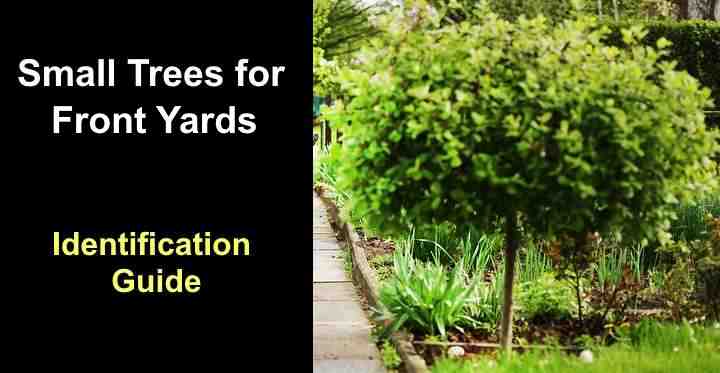
Planting small trees in your front yard is an excellent way to boost curb appeal. Small flowering, weeping, and evergreen trees help to enhance a compact front yard landscape. They add beautiful colors, interesting shapes, and year-long visual appeal to the front of your house. Additionally, small decorative trees under 10 feet (3 m) tall in a front yard can provide a measure of shade without casting a shadow over your home.
You can plant small trees in your front garden to support local ecosystems. For example, dwarf flowering trees in a front yard attract birds, butterflies, and pollinators. Additionally, some small evergreen trees can provide shade from the hot sun, and still look attractive in the winter. And small ornamental weeping trees look spectacular in the front of your property.
Suppose you want to improve the appearance of your front yard. In that case, this article lists the top ornamental trees suitable for small spaces. In addition, you will learn about suitable small flowering trees, dwarf weeping trees, and evergreen trees that enhance curb appeal.
How to Select Small Trees for the Front of House Planting
Choosing small trees for your front yard requires considering a few things before planting them. First, ensure you choose a dwarf variety of ornamental trees. Ideally, the small decorative tree’s mature height shouldn’t be more than 10 feet (3 m). Additionally, it would be best to choose a small landscaping tree suitable for your climate, sun exposure, and moisture levels.
There are also other considerations when selecting a small tree for landscaping. For example, small evergreen trees are ideal as privacy trees. Or maybe, you would like to enjoy spring blossoms or fruit from your tree. If so, think about a dwarf apple tree or a weeping cherry tree.
Then there is the issue of the landscaping tree’s size, shape, and color. For example, some decorative trees for a front yard have stunning red foliage or beautiful fall colors. In contrast, others are prized for their stunning colorful spring and summer flowers.
Small Ornamental Trees for the Front Yard (With Pictures) – Identification Guide
Small decorative weeping trees are popular in small front yards because they add tremendous visual value without taking up much space. Their graceful cascading branches create a focal point in front of your house or enhance a flower bed. Here are four dwarf weeping trees to consider planting.
‘Red Dragon’ Weeping Japanese Maple Tree (Acer palmatum dissectum ‘Red Dragon’)
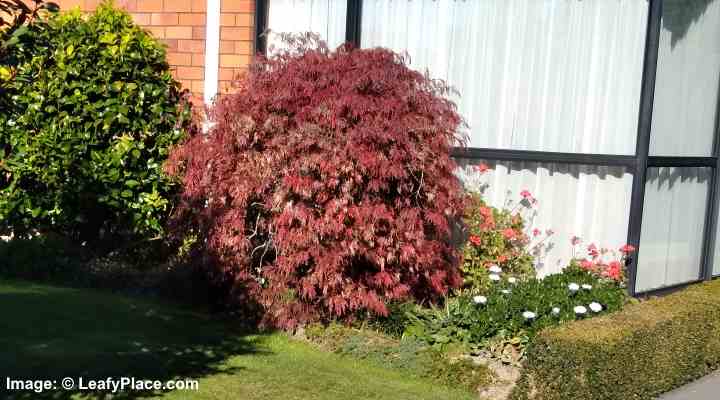
The small ornamental ‘Red Dragon’ Japanese maple tree has beautiful weeping red-purple foliage that enhances the curb appeal of the front of the house
The weeping Japanese maple ‘Red Dragon’ is an eye-catching dwarf tree that can add a pop of color to front yards with its stunning burgundy lacy palm-like leaves. The red-leaved weeping tree retains its color throughout the season before turning vivid red and crimson in the fall.
The ‘Red Dragon’ Japanese maple tree grows between 6 and 8 ft. (1.8 – 2.4 m) tall and only 5 ft. (1.5 m) wide. The deciduous weeping small maple tree is best planted in partial shade to retain its vibrant red foliage throughout summer. This ornamental foliage tree is suitable for USDA zones 5 to 8.
Mature Size: 6 and 8 ft. (1.8 – 2.4 m) tall and only 5 ft. (1.5 m) wide
USDA Hardiness Zones: 5 to 8
Sun: Partial shade
Japanese Weeping Cherry (Prunus serrulata ‘Kiku-Shidare-Zakura’)
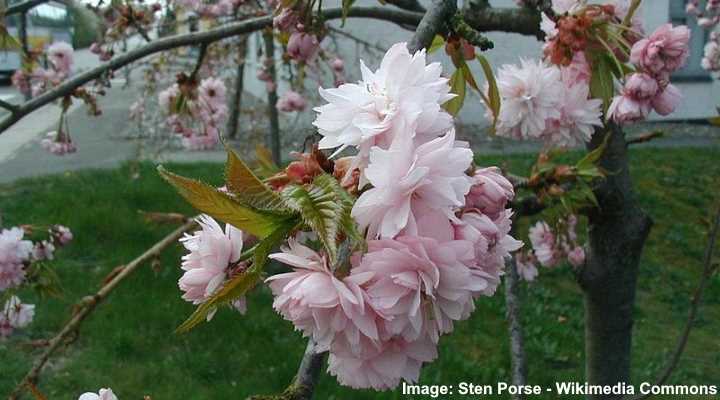
The flowering Japanese weeping cherry tree has showy ruffled pink flowers and is great as a landscaping tree for the front yard
Flowering cherry trees look stunning in front yards, and the Japanese weeping cherry tree is no exception. The small cherry blossom tree with cascading branches and beautiful double, rich pink powder-puff flowers brighten spring front gardens. The clusters of flowers enhance the bronze-emerging leaves that turn dark green in summer.
‘Kiku-Shidare-Zakura’ dwarf weeping cherry tree typically grows 8 to 10 ft. (2.4 – 3 m) tall and wide. The landscaping tree’s showy flowers, colorful fall foliage, and bronze bark give the decorative tree year-long visual interest.
Plant the Japanese weeping cherry tree in full sun in USDA zones 4 to 9 for best results.
Mature Size: 8 to 10 ft. (2.4 – 3 m) tall and wide
USDA Hardiness Zones: 4 to 9
Sun: Full sun
Weeping Eastern Redbuds (Cercis canadensis ‘Lavender Twist’ and ‘Ruby Falls’)

Images of Eastern redbud ‘Lavender Twist’ (also called ‘Covey’) which is a dwarf weeping cultivar of Eastern redbud tree
Two flowering weeping eastern redbud trees are perfect for planting in a front yard and enhancing the curb appeal— ‘Lavender Twist and ‘Ruby Falls.’ These eastern redbud cultivars, with their pendulous branches, grow around 6 ft. (1.8 m) tall and are identified by their spectacular pink flowers.
The ‘Lavender Twist’ weeping redbud tree is a slow-growing landscaping tree that grows 5 to 6.5 ft. (1.5 – 2 m) tall and wide. This small weeping redbud has a twisted trunk and branches. Expect to see small pinkish-purple flowers appear in early spring, followed by obovate leaves that turn yellow in the fall.
The ‘Ruby Falls’ weeping redbud tree grows 6 ft. (1.8 m) tall and 4 ft. (1.2 m) wide. ‘Ruby Falls’ has beautiful pink spring flowers, deep green-burgundy heart-shaped leaves, and eye-catching yellow fall foliage. Plant the tree in full sun to partial shade in USDA zones 5 to 9.
Mature Size: Around 6 ft. (1.8 m)
USDA Hardiness Zones: 5 to 9
Sun: Full sun to partial shade
Dwarf Weeping Mulberry (Morus alba ‘Chaparral’)
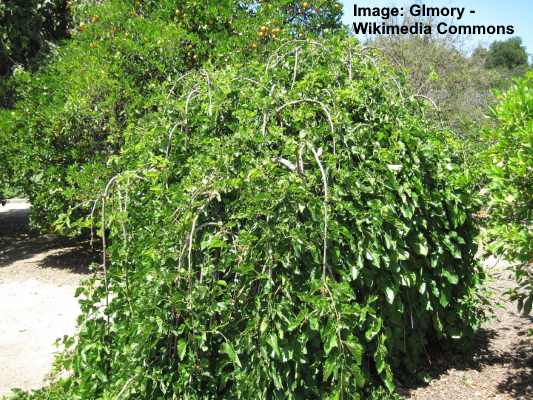
The decorative ‘Chaparral’ cultivar is a type of dwarf weeping mulberry tree which is suitable for landscaping small front gardens
The dwarf weeping mulberry ‘Chaparral’ is a popular small tree for planting in front yards due to its attractive cascading branching habit. Also known as the white mulberry, this landscaping tree is identified by its glossy-green large leaves, whitish-green flowers, umbrella-like crown, and branches that droop to the ground.
This dwarf weeping landscape tree grows 6 to 8 ft. (1.8 – 2.4 m) high and up to 12 ft. (3.6 m) wide. Its attractive weeping appearance, white fruits, and shiny foliage give it tremendous landscaping appeal at the front of the house.
Mature Size: 6 to 8 ft. (1.8 – 2.4 m) tall and up to 12 ft. (3.6 m) wide
USDA Hardiness Zones: 4 to 8
Sun: Full sun to partial shade
Small Flowering Trees For Front of House Planting
Planting small flowering trees is a great way to enhance the curb appeal of your property. Trees with pink, white, red, and multi-colored blossoms can beautify your front-of-home landscape from spring through fall. Additionally, their wonderful colors and fragrance welcome anyone visiting your home.
Sargent Crabapple (Malus sargentii)

The Sargent crabapple is an attractive, small, white-flowering tree with ornamental fruit
The ‘Sargent’ crabapple is a small flowering tree with stunning white flowers blooming in the spring, ideal for small front gardens. This attractive ornamental tree is identified by its zigzag branches, wide, spreading crown, dense foliage, and white blossoms. In addition, you also get a harvest of small crabapples later in the season.
The compact crabapple tree is a landscape tree growing less than 10 ft. (3 m) tall. Its average size is between 6 and 10 ft. (1.8 – 3 m) tall and 12 feet (3.6 m) wide. The attractive features of the ornamental fruit tree are its white spring flowers, a spreading canopy of dark green leaves turning golden yellow in the fall, and its unusual branching pattern.
Mature Size: 6 to 10 ft. (1.8 – 3 m) tall and 12 feet (3.6 m) wide
USDA Hardiness Zones: 4 to 7
Sun: Full sun
Dwarf Eastern Redbud ‘Ace of Hearts’ (Cercis canadensis ‘Ace of Hearts’)
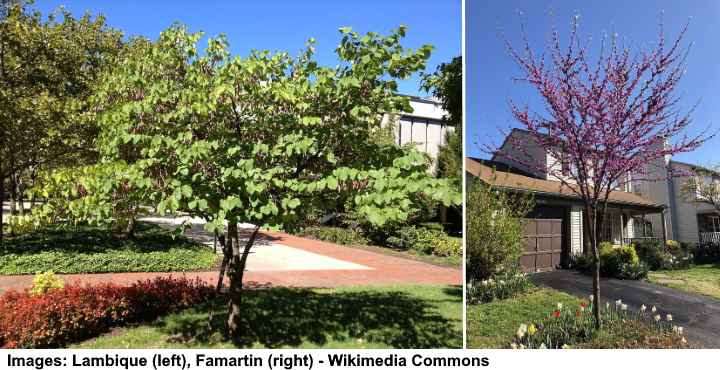
The eastern redbud trees include several small cultivars for landscaping small sunny gardens or the front of the house
The dwarf eastern redbud cultivar ‘Ace of Hearts’ is identified by its attractive clusters of pea-like reddish-purple blossoms. Other features of this small eastern redbud are its interesting irregular branching habit, dark green leaves that turn yellow in the fall, and masses of pink flowers on bare branches.
The dwarf eastern redbud ‘Ace of Hearts’ grows 9 to 12 ft. (2.7 – 3.6 m) tall and 10 to 15 ft. (3 – 4.5 m) wide. It is a stunning landscape tree for a sunny spot or accent planting in your front yard. It thrives in USDA zones 5 through 9.
Mature Size: 9 to 12 ft. (2.7 – 3.6 m) tall and 10 to 15 ft. (3 – 4.5 m) wide
USDA Hardiness Zones: 5 to 9
Sun: Full to partial sun
Dwarf Crape Myrtle Trees (Lagerstroemia)
Dwarf crape myrtle trees are large shrubs or small trees that make great additions to small spaces and front yards. The dwarf flowering trees are characterized by large, colorful flower clusters blooming in shades of white, pink, and deep red. The dwarf flowering trees typically grow between 6 and 10 ft. (1.8 – 3 m) tall.
Some crape myrtles are multi-stemmed landscaping trees with interesting peeling bark. However, all the dwarf cultivars are prized for the spectacular floral displays throughout summer.
Here are some dwarf flowering crape myrtle cultivars under 10 ft. (3 m) tall suitable for planting in a front yard.
Acoma Crape Myrtle (Lagerstroemia indica x fauriei ‘Acoma’)
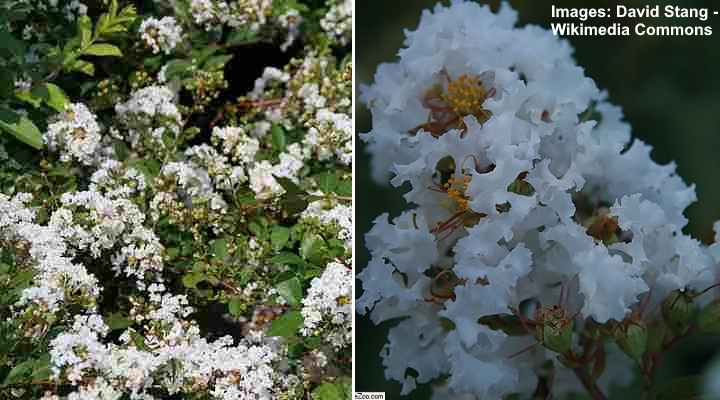
Acoma Crape Myrtle (Lagerstroemia indica x fauriei ‘Acoma’)
This multi-stemmed dwarf crape myrtle tree has an abundance of clusters of pure white flowers consisting of ruffled petals. It’s a hardy cultivar of great ornamental value due to its spectacular flowers, lush foliage, and attractive bark. It grows 10 ft. (3 m) tall.
Tonto Crape Myrtle (Lagerstroemia indica x fauriei ‘Tonto’)

Crape Myrtle Tonto (Lagerstroemia indica x fauriei ‘Tonto’)
This ornamental flowering tree is characterized by its vibrant pinkish-red flowers and lush green leaves turning purplish-red in the fall. The landscaping tree doesn’t grow taller than 10 ft. (3 m) tall and wide.
Rhapsody in Pink Crape Myrtle (Lagerstroemia indica ‘Whit VIII’)

Rhapsody in Pink Crape myrtle
The deciduous dwarf ornamental tree has bright pink spring flowers, dark-green foliage, and compact growth habit. The dwarf decorative tree grows 6 to 10 ft. (1.8 – 3 m) in height.
Mature Size: 6 to 10 ft. (1.8 – 3 m)
USDA Hardiness Zones: 6 to 9
Sun: Full sun
Star Magnolia (Magnolia stellata)
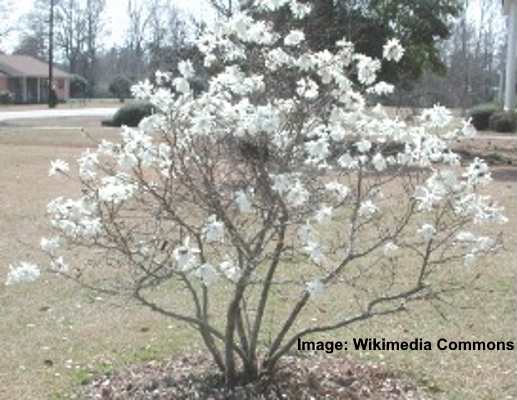
The small flowering star magnolia tree is a beautiful ornamental tree with white fragrant flowers
The small, flowering ornamental Star Magnolia is a decorative multi-stemmed tree famed for its masses of star-shaped pure white, fragrant spring flowers. The showy snow-white blossoms measure 4” (10 cm), and each contains around 18 strap-like petals, giving them a ruffled appearance. These attractive white flowers contrast with dark-green shiny leaves that turn yellow-brown in the fall.
The ornamental star magnolia shrub-like tree grows 6.5 ft. (2 m) tall and wide. It’s a beautiful addition to any front yard, and its compact size makes it extremely versatile. This decorative small flowering tree thrives in full sun or light shade. Suitable for USDA hardiness zones 4 through 8.
Mature Size: 6.5 ft. (2 m) tall and wide
USDA Hardiness Zones: 4 to 8
Sun: Full sun to light shade
Small Decorative Trees For Front Yard
Many small decorative trees are ideal for planting in front yards because of their attractive foliage, compact growth, and relatively low height. Here are some varieties perfect for many front-of-house landscape designs.
Shaina Small Japanese Maple (Acer palmatum ‘Shaina’)
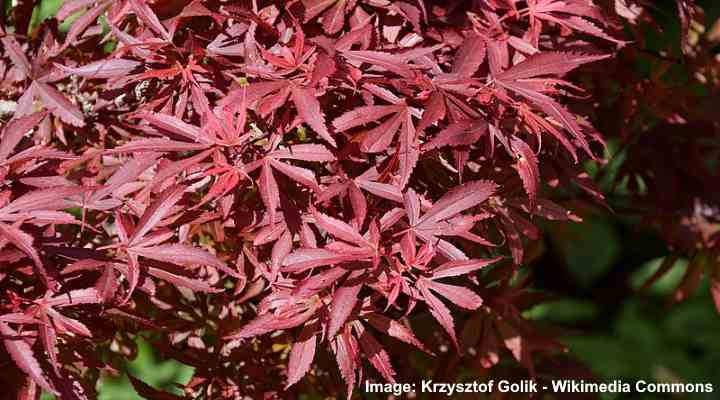
The small Shaina Japanese maple tree provides colorful foliage and grows in full sun to partial shade
The Japanese maple cultivar ‘Shaina’ is an attractive deciduous tree identified by its spectacular deep red palmate leaves and reddish-purple flowers. Ideal for a compact front yard, the Shaina Japanese maple grows 4 to 5 ft. (1.2 – 1.5 m) tall and 3 to 4 ft. (1 – 1.2 m) wide.
This slow-growing ornamental tree has an attractive globe-shaped habit, making it perfect for landscaping a front yard where space is limited. You can plant the decorative red-leaved Japanese maple in full sun or partial shade and well-drained soil. It is suitable for USDA zones 5 to 9.
Mature Size: 4 to 5 ft. (1.2 – 1.5 m) tall and 3 to 4 ft. (1 – 1.2 m) wide
USDA Hardiness Zones: 5 to 9
Sun: Full sun or partial shade
Dwarf Red-Flowering Camellia Trees
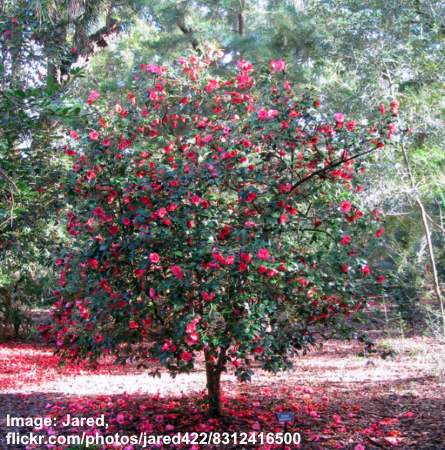
Dwarf red-flowering camellia tree adds a focal point to any front garden
Are you looking for a red-flowering dwarf ornamental tree for your front yard? In that case, a red camellia tree is a wonderful addition to a compact landscape. Red camellias grow less than 10 ft. (3 m) tall, with some dwarf varieties only reaching 4 to 5 ft. (1.2 – 1.5 m) high.
Red camellias are identified by their showy deep red flowers with contrasting yellow stamens in the center. These heat-loving trees bloom from October through December, adding color to winter landscapes. Plant the trees as a focal point, accent, or lawn tree.
Mature Size: Usually 4 to 5 ft. (1.2 – 1.5 m)
USDA Hardiness Zones: 7 to 9
Sun: Usually partial shade to partial sun
Purple Leaf Sand Cherry Tree (Prunus x cistena)

The small purple leaf sand cherry tree has stunning pink flowers and colorful foliage
The purple leaf sand cherry is a great small tree for front yard landscaping due to its spectacular blooms early in the season. The multi-stemmed ornamental tree blooms with masses of pinkish-white cherry blossoms. Its attractive leaves turn shades of green, yellow, orange, and red during the growing season. Additionally, the cherry blossom tree produces edible berries.
The purple leaf sand cherry tree grows 6.5 ft. (2 m) tall. The small size tree is suitable for smaller front gardens or containers. Also, due to its shrub-like growth, you can plant it as a hedge around your front yard. It’s suitable for USDA zones 2 through 8.
Mature Size: 6.5 ft. (2 m)
USDA Hardiness Zones: 2 to 8
Sun: Full sun
American Snowbell Tree (Styrax americanus)
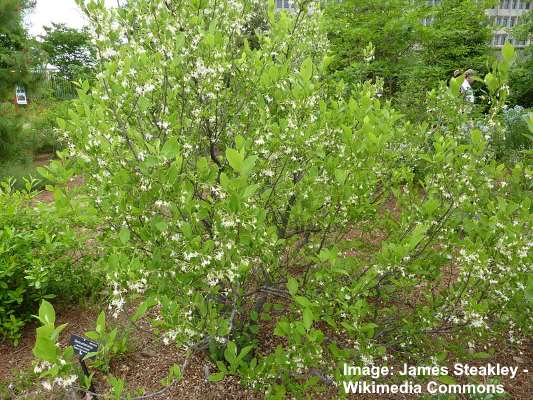
The American snowbell is a small multi-stemmed tree with attractive flowers and fall colors
The native American snowball tree is a small shrub-like tree with multiple stems, deciduous leaves, and white bell-shaped flowers. Other attractive features of the American snowbell are its elliptical light green and attractive yellow-green fall color. In bloom during late spring and early summer, the tree is covered in dangling white flowers.
The attractive American snowball tree is suitable for planting in front yards with poor drainage. It’s a slow-grower and grows 6 to 10 ft. (1.8 – 3 m) tall and wide and has an attractive rounded habit. It grows best in USDA zones 6 to 8.
Mature Size: 6 to 10 ft. (1.8 – 3 m) tall and wide
USDA Hardiness Zones: 6 to 8
Sun: Full sun to partial shade
Pygmy Date Palm (Phoenix roebelenii)
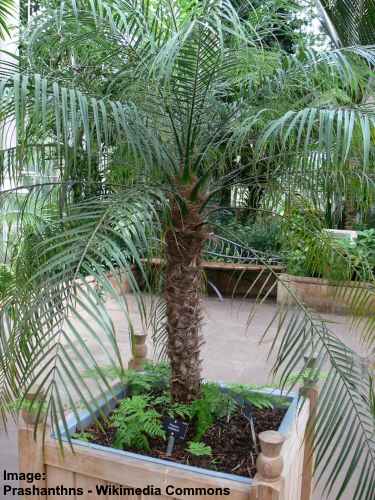
The pygmy date palm is a dwarf tree with a spiky trunk that can accentuate any front yard
Plant a pygmy date palm in your front yard to give your landscape an exotic look. The pygmy palm is a small palm tree with a graceful arched crown. Its arching fronds create an explosion of tropical foliage at the end of the trunk. Pygmy palms grow 6 ft. (1.8 m) tall and 3 to 5 ft. (1 – 1.5 m) wide.
Pygmy date palm trees are suitable for USDA zones 10 and 11. Therefore, you can grow them successfully in a front yard in Florida or other warm climates.
Mature Size: 6 ft. (1.8 m) tall and 3 to 5 ft. (1 – 1.5 m) wide
USDA Hardiness Zones: 10 to 11
Sun: Full sun to partial shade
Small Evergreen Trees for Front Yard
Evergreen trees add height and structure to any landscape. They also provide year-round interest and beauty. Some evergreen trees have been selected specifically for their small size. Here are a few examples of small evergreen trees for front-of-the-house planting.
Irish Yew ‘Fastigiata’ (Taxus baccata ‘Fastigiata’)
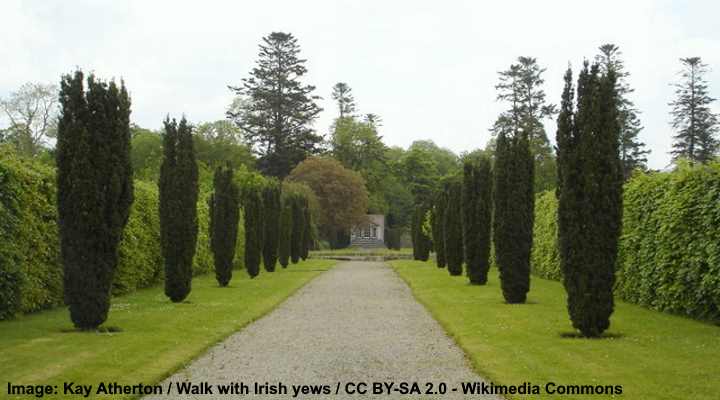
The dwarf columnar evergreen Irish yew doesn’t take much space in small spaces or flowers beds
The Irish yew cultivar ‘Fastigiata’ is a dwarf, evergreen conical coniferous tree with needle-shaped leaves and small red berries. This ornamental conifer has a slow growth rate and grows 4.5 to 10 ft. (1.4 – 3 m) in ten years. But because of its compact, columnar habit, the evergreen won’t take up much room in a front yard.
The Irish yew ‘Fastigiata’ is a versatile columnar evergreen tree for compact landscapes. Thriving in full sun in USDA zones 6 to 8, the small evergreen tree is ideal for growing as an accent tree, hedgerow, foundation planting, or privacy screen.
Mature Size: Around 4.5 to 10 ft. (1.4 – 3 m)
USDA Hardiness Zones: 6 to 8
Sun: Full sun
Sky Pencil Holly (Ilex crenata ‘Sky Pencil’)
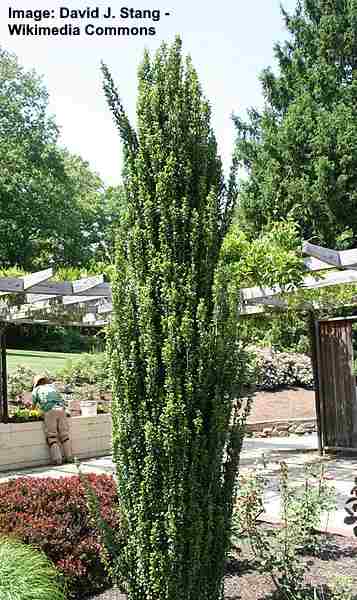
Sky Pencil holly has narrow growth habit and evergreen foliage
The slender shrub-like holly tree ‘Sky Pencil’ is a small, evergreen ornamental tree with a narrow growth habit. This evergreen tree is perfect for compact front yards as it grows 4 to 10 ft. (1.2 – 3 m) tall and wide. The thin ‘Sky Pencil’ Holly is identified by its dark berry-like drupes, glossy green leaves, and slender growing habit.
You can plant this ornamental tree in full sun in USDA zones 5 to 8.
Mature Size: 4 to 10 ft. (1.2 – 3 m) tall and wide
USDA Hardiness Zones: 5 to 8
Sun: Full sun
Evergreen Dwarf Pencil Point Juniper Tree (Juniperus communis ‘Compressa’)

Plant a dwarf pencil point juniper tree in narrow spaces in your front garden
Are you looking for a narrow, columnar evergreen tree to add visual appeal to a front yard? If so, the juniper ‘Compressa’ is an ideal choice. This dwarf pencil evergreen grows up to 5 ft. (1.5 m) tall and 1 ft. (0.3 m) wide. You can grow the small conifer in a front yard in USDA zones 2 to 6.
The versatile landscaping juniper tree is ideal as a cone-shaped accent tree, foundation planting, or container plant.
Mature Size: Up to 5 ft. (1.5 m) tall and 1 ft. (0.3 m) wide
USDA Hardiness Zones: 2 to 6
Sun: Full sun
Dwarf Alberta Spruce Tree (Picea glauca ‘Conica’)
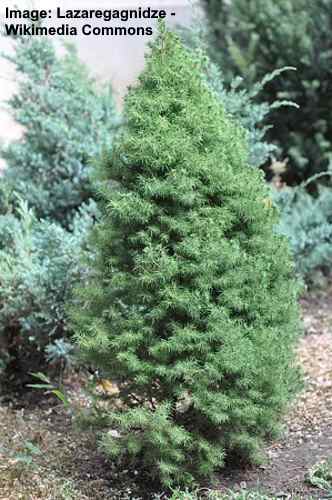
Dwarf Alberta spruce is a small columnar tree with a slow growth rate
The dwarf Alberta spruce ‘Conica’ cultivar is a conical, evergreen shrub-like small tree, perfect for small front yards. The compact cone-shaped spruce grows as a small landscaping tree, characterized by soft, fragrant, light bluish-green foliage. In addition, this miniature tree works well as a foundation plant, accent tree, or low-growing hedge.
The slow-growing spruce grows up to 4 ft. (1.2 m) tall and 3 ft. (1 m) wide. The evergreen landscaping tree is suitable for planting in USDA zones 5 through 7.
Mature Size: 4 ft. (1.2 m) tall and 3 ft. (1 m) wide
USDA Hardiness Zones: 5 to 7
Sun: Full sun
Fernleaf Full Moon Maple Tree (Acer japonicum ‘Aconitifolium’)
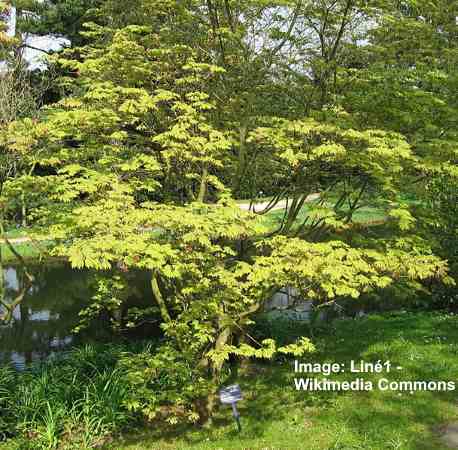
The dwarf ornamental fernleaf full moon maple is a compact deciduous tree with attractive feathery foliage and autumn color
If you’re looking for an attractive, small ornamental tree for your front yard, consider the fernleaf full moon maple. The tree is known for its stunning bright red or orange foliage in autumn. This small maple tree also features mid-green, palmate, fern-like leaves, adding to its visual appeal. Other identifying features include small red flowers, winged maple seeds, and a dense, compact branching habit.
The fernleaf full moon maple grows around 8 to 10 ft. (2.4 – 3 m) tall and wide, making it suitable for smaller gardens. This low-maintenance tree is ideal for growing as a specimen plant around patios or as an accent tree. It’s perfect for adding a pop of brilliant color and visual interest to a fall garden.
Mature Size: 8 to 10 ft. (2.4 – 3 m)
USDA Hardiness Zones: 5 to 7
Sun: Full sun to partial shade
Small Ornamental Chaste Tree (Vitex agnus-castus)

Chaste Tree (Vitex agnus-castus)
The chaste tree is a small ornamental tree with a compact growth habit, making it the perfect choice for enhancing the appearance of your yard. Blooming in late summer, the tree showcases attractive flower spikes ranging in color from purple to blue-violet. Commonly referred to as the monk’s pepper, this deciduous tree features grayish-green, opposite, palmately-compound leaves and rounded fruits known as chasteberries.
This small tree reaches around 8 to 10 ft. (1.8 – 3 m) tall. For the best results, plant in moist, well-drained soil. It is also tolerant of salt spray and drought conditions. The tree makes a fantastic addition to cottage gardens, mixed borders, and xeriscapes. The blue-violet blooms are also highly suitable for creating beautiful arrangements as cut flowers or for preserving in dried floral displays.
Mature Size: 8 to 10 ft. (1.8 – 3 m)
USDA Hardiness Zones: 7 to 9
Sun: Full sun
Japanese Flowering Quince (Chaenomeles Japonica)
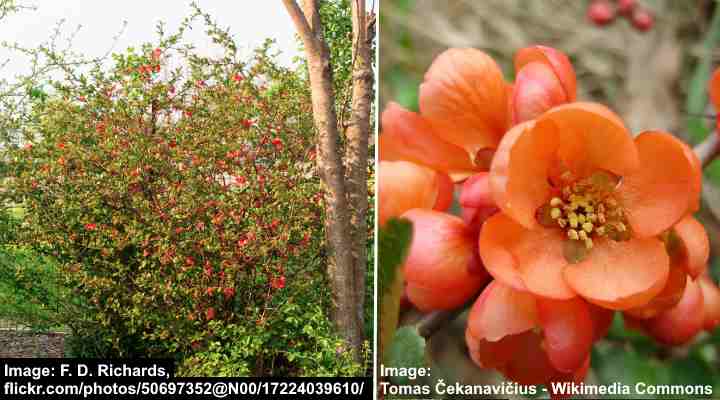
Known for its beautiful, five-petaled, orange-scarlet flowers, the Japanese flowering quince is an attractive addition to any front yard. This shrubby ornamental tree is characterized by its cup-shaped flowers, rounded canopy shape, and globose, golden-yellow to light-green apple-like fruits. The leaves are alternate, lanceolate, glossy, and mid-green in color. The tree begins blooming in late winter or early spring, lasting for a couple of weeks.
The compact, decorative Japanese flowering quince tree thrives in organically fertile, moist, well-draining soil. As an incredibly versatile tree, it can be used in a wide variety of ways to enhance your front yard’s curb appeal. You can use it as a low-flowering hedge, lovely shrub border plant, or a stunning focal point. Additionally, its branches are covered in thorns, making it a great option as an effective security screen around your yard.
Mature Size: 2 to 3 ft. (0.6 – 1 m) tall and 3 to 6 ft. (1 – 1.8 m) wide
USDA Hardiness Zones: 5 to 9
Sun: Full sun to partial sun
Chinese Plum Tree (Prunus glandulosa)
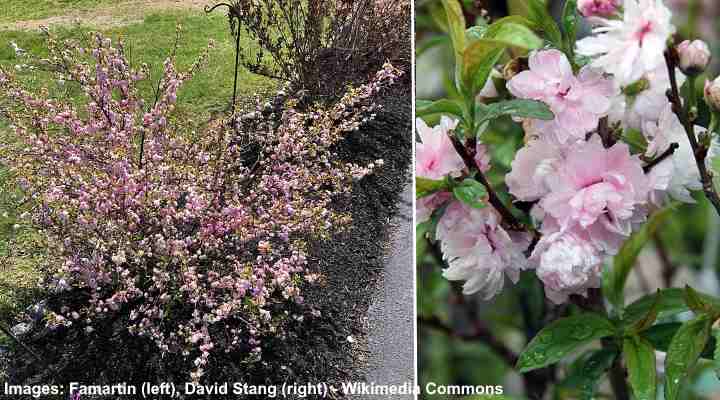
The Chinese plum tree is an eye-catching miniature tree with a spiky, shrub-like growth habit. Perfect for planting in small yards, the tree is recognized for its stunning clusters of single or double, pale-pinkish flowers that bloom in spring. This small, pink-flowering tree also showcases light-green, pointy, oval-shaped leaves that transition into a stunning yellow-orange color in the fall. Although rare, it may occasionally produce round, dark red fruits that beautifully contrast against the lush, light-green foliage.
To ensure the best growth, plant the Chinese plum tree in moist, well-draining soil that is rich in organic material. This tree can be grown as a beautiful focal point to enhance your front yard’s curb appeal. It may also be grown as an accent plant, a specimen plant, or a low-flowering hedge. Its presence is guaranteed to add a touch of beauty to any garden.
Mature Size: 4 to 5 ft. (1.2 – 1.5 m) tall and wide
USDA Hardiness Zones: 4 to 8
Sun: Full sun to partial shade
Yellow Oleander (Cascabela thevetia)

The yellow oleander is an attractive, tropical evergreen tree with a shrub-like form. The blossoms display a striking hue of golden-yellow and have a trumpet-like shape. They grow in scattered clusters at the tips of their branches. This yellow-flowering decorative tree also features willow-like, glossy green leaves that beautifully contrast against the golden-yellow blooms. Another identifying feature is its round, green seed pods that turn black when ripe, enhancing its overall appeal.
The yellow oleander grows best in moist, fertile, well-drained soil. Although popular for its decorative features, it’s important to note that all parts of the tree are toxic if ingested. Make sure to exercise caution when planting in areas frequented by children or pets. Despite this, its lush, glossy green foliage and beautiful yellow flowers make it a great choice for planting in your front yard to enhance curb appeal.
Mature Size: Up to 8 ft. (2.4 m) tall and 4 ft. (1.2 m) wide
USDA Hardiness Zones: 8 to 10
Sun: Full sun to partial shade
Weeping Scotch Laburnum (Laburnum alpinum ‘Pendulum’)
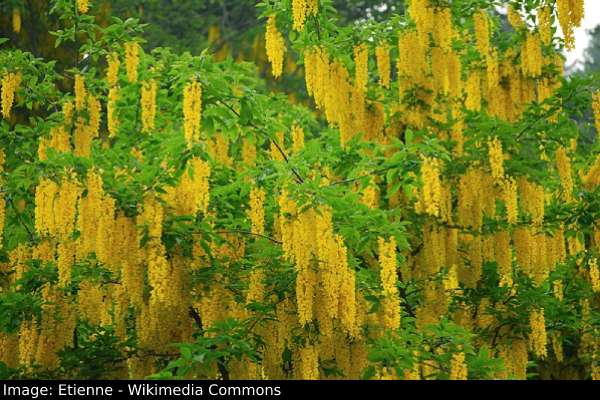
The weeping scotch laburnum is a stunning deciduous tree characterized by its fragrant, hanging yellow flower clusters. This small, yellow-flowering tree blooms in late spring, usually from May until June. The branches grow together to form an umbrella shape, giving it a distinct appearance. Its cascading branches and small size make it a great option for planting in front yards. The tree also has glossy, mid-green leaves that are trifoliate in shape.
Plant the weeping scotch laburnum in any well-draining soil. This beautiful ornamental tree makes an ideal focal point to improve the appearance of your garden. It can also be used as an accent or specimen plant in your front yard. With its eye-catching appearance and scentful yellow flowers, the weeping scotch laburnum is guaranteed to add a touch of beauty and elegance to your outdoor space.
Mature Size: 6.5 to 8 ft. (2 – 2.5 m) tall and up to 6.5 ft. (2 m) wide
USDA Hardiness Zones: 5 to 7
Sun: Full sun or partial shade
Flame Azalea (Rhododendron calendulaceum)

The flame azalea is an excellent small tree for front yards because of its compact, bushy habit and bright orange, star-shaped flowers. The tree has oval-shaped, mid-green leaves with a slightly hairy texture and an elliptic shape. Its leaves also transition into a spectacular red or yellow hue before dropping in late fall, adding to its decorative appeal.
For optimal growth, plant the flame azalea in acidic, moist, well-drained soil. This attractive, decorative tree is a great choice for use as a privacy screen, flowering hedge, or standout focal point. Keep in mind that all parts of the plant are toxic if ingested, so be cautious when planting this tree in areas frequented by children or pets.
Mature Size: 4 to 8 ft. (1.2 – 2.4 m) tall and wide
USDA Hardiness Zones: 5 to 8
Sun: Partial shade or full sun
Waratah (Telopea speciosissima)

Consider planting the waratah in your front yard due to its distinctive red flower heads and compact size. This spring-blooming tree is known mostly for its stunning flower heads, but it also features large, vivid leafy bracts that range in color from red, maroon, or pink. Additionally, the tree has dark green, glossy leaves with serrated edges, adding to its ornamental appeal.
The waratah grows best in moist, well-drained, sandy-loam soils. Their gradual growth and compact, shrub-like appearance make them great options for planting as an individual focal point, accent plant, or solitary specimen tree. Consider planting the waratah tree in warm, tropical gardens to add a pop of color.
Mature Size: 3 to 10 ft. (1 – 3 m) tall and wide
USDA Hardiness Zones: 8 to 10
Sun: Full sun to partial shade
Red Flowering Grevillea Trees
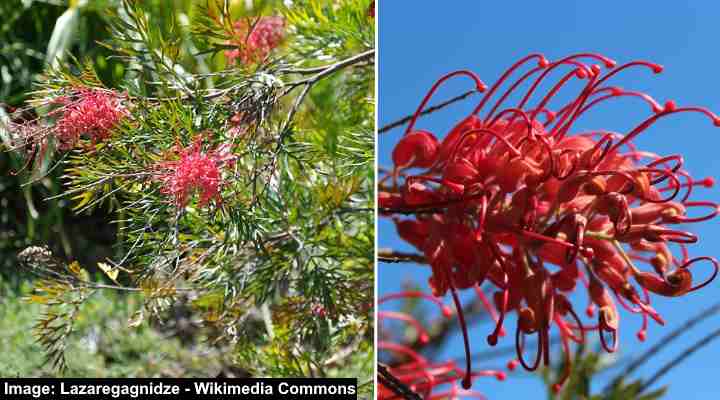
Red flowering grevilleas are attractive, evergreen trees recognized for their stunning clusters of bright red flowers that resemble traditional waratah blooms. With their unique flowers and compact size, red flowering grevilleas are perfect for enhancing the curb appeal of your front yard. The flowers are especially inviting to birds, bees, and hummingbirds, making the tree a valuable addition to wildlife gardens. These trees also showcase slender, pinnately compound, fern-like leaves that are dark green to silver-gray in color.
To ensure the best possible growth, it’s essential to plant the flowering grevillea tree in soil that has good drainage. These highly versatile trees can serve as hedges, screens, and specimen plants, adding both beauty and elegance to your front yard. Consider planting red flowering grevilleas for their vibrant red blooms that are guaranteed to enhance the appearance of your outdoor space.
Mature Size: 4 to 8 ft. (1.2 – 2.4 m) tall, depending on the species
USDA Hardiness Zones: 9 to 11
Sun: Full sun to partial shade
Common Lilac (Syringa vulgaris)
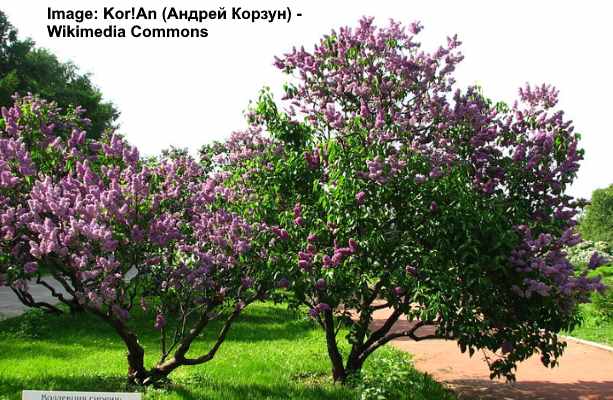
Lilac tree
The common lilac is a great small tree for front yards due to its beautiful, compact bushy form. The upright branches are decorated with beautiful cone-shaped clusters of highly fragrant, pinkish-purple flowers. The flowers are multi-colored, coming in delightful hues of white, pink, or blue. It also showcases decorative, heart-shaped leaves that range in color from bluish-green to dark green, adding a decorative touch to its overall appearance.
The common lilac is best planted in moist, well-draining soil. This tree, resembling a shrub, boasts lush and attractive foliage, making it an ideal choice for hedges, privacy screens, or as a solitary tree. Opt for these plants to enhance your garden as they ensure consistent spring blossoms and emit a captivating fragrance that lures in bees and butterflies.
Mature Size: 8 to 10 ft. (2.4 – 3 m) tall and 5 to 6 ft. (1.5 – 1.8 m) wide
USDA Hardiness Zones: 3 to 8
Sun: Full sun for best flowering
Angel’s Trumpet (Brugmansia suaveolens)
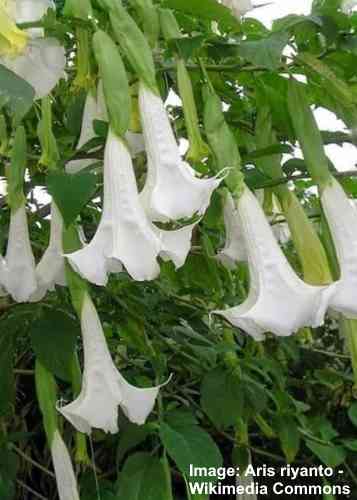
The angel’s trumpet is a tropical, evergreen tree renowned for its hanging, creamy-white bell-shaped flowers. Its leaves are dark-green, oval-shaped, and covered with thin hairs. The tree has a dense, vase-like canopy, making it perfectly suitable for small front yards. It may also produce round, yellow-green drupes.
For optimal growth, plant the angel’s trumpet in fertile, organically rich soil that is well-draining. This versatile tree can greatly enhance the curb appeal of your front yard. This small ornamental tree can also be used to add a tropical touch to garden beds, borders, patios, and decks. Note that all parts of this plant are toxic when ingested, so be cautious when planting in areas where there might be children or pets.
Mature Size: 3 to 8 ft. (1 – 2.4 m) tall and 2 to 4 ft. (0.6 – 1 m) wide
USDA Hardiness Zones: 9 to 11
Sun: Full sun or partial shade
Flowering Maple ‘Victor Reiter’ (Abutilon ‘Victor Reiter’)
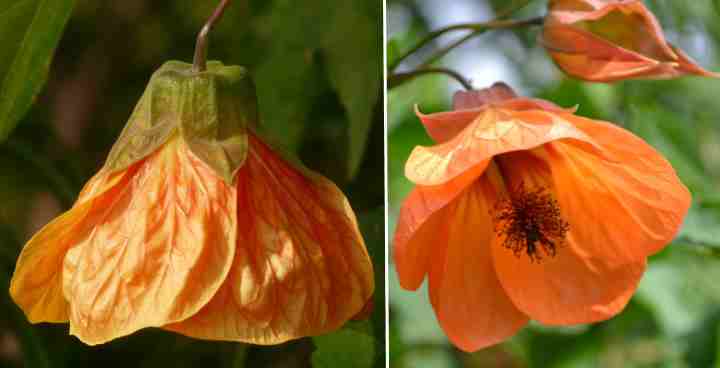
Suitable for small-scale backyards, the ‘Victor Reiter’ flowering maple is a beautiful evergreen tree characterized by its attractive pale-orange, bell-shaped flowers. These elegant blossoms dangle gracefully from the branches and showcase greenish-yellow centers, adding a touch of beauty to the overall appearance. Additionally, the tree features glossy, maple-like dark-green leaves that create a beautiful contrast against the orange blooms.
‘Victor Reiter’ flowering maples grow best in moist, organically rich, well-draining soil. These trees, covered with captivating peach-colored blossoms, have the potential to create an appealing focal point in your front yard. In addition, they serve as a fantastic decorative choice for infusing small gardens, container gardens, or any landscape with a vibrant splash of color.
Mature Size: 6 to 8 ft. (1.8 – 2.4 m) tall and 4 ft. (1.2 m) wide
USDA Hardiness Zones: 9 to 11
Sun: Full sun to partial shade
Related articles:
